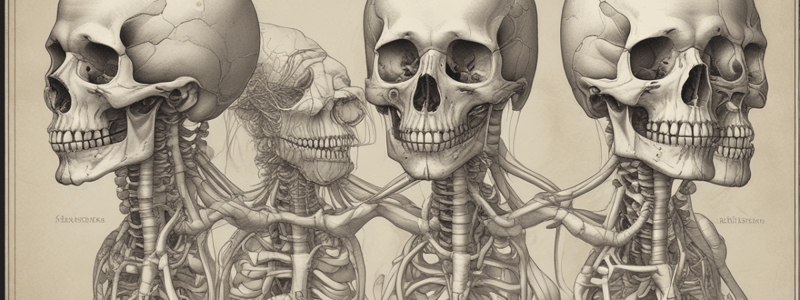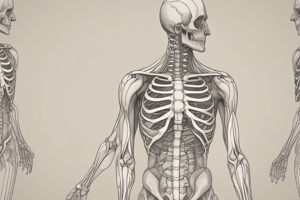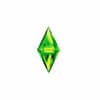Podcast
Questions and Answers
What is the primary function of the thoracic wall?
What is the primary function of the thoracic wall?
- To move air into and out of the lungs (correct)
- To protect the spine
- To support the shoulder girdle
- To facilitate blood circulation
What is the name of the partition that separates the pleural cavities?
What is the name of the partition that separates the pleural cavities?
- Diaphragm
- Mediastinum (correct)
- Visceral pleura
- Parietal pleura
What is the main function of the mediastinum?
What is the main function of the mediastinum?
- To protect the heart
- To support the shoulder girdle
- To facilitate breathing
- To act as a conduit for structures passing through the thorax (correct)
What is the name of the muscle that plays a crucial role in inspiration?
What is the name of the muscle that plays a crucial role in inspiration?
What is the name of the cavity that surrounds the heart?
What is the name of the cavity that surrounds the heart?
What is the purpose of the thoracic wall?
What is the purpose of the thoracic wall?
What is the name of the soft tissue that lines the thoracic wall?
What is the name of the soft tissue that lines the thoracic wall?
What is the function of the thoracoabdominal pump?
What is the function of the thoracoabdominal pump?
What is the name of the muscle that assists in the lifting of heavy weights?
What is the name of the muscle that assists in the lifting of heavy weights?
What is the name of the cavity that surrounds the lungs?
What is the name of the cavity that surrounds the lungs?
Which part of the sternum articulates with the 1st costal cartilage and the upper part of the 2nd costal cartilage on each side?
Which part of the sternum articulates with the 1st costal cartilage and the upper part of the 2nd costal cartilage on each side?
What is the function of the three layers of flat muscles in the lateral thoracic wall?
What is the function of the three layers of flat muscles in the lateral thoracic wall?
How many thoracic vertebrae make up the posterior part of the thoracic wall?
How many thoracic vertebrae make up the posterior part of the thoracic wall?
What is the term for the notch in the midline of the superior surface of the manubrium?
What is the term for the notch in the midline of the superior surface of the manubrium?
What type of ribs are the 8th, 9th, and 10th ribs?
What type of ribs are the 8th, 9th, and 10th ribs?
What is the term for the joint between the manubrium and the body of the sternum?
What is the term for the joint between the manubrium and the body of the sternum?
What is the function of the ribs in the lateral thoracic wall?
What is the function of the ribs in the lateral thoracic wall?
What is the term for the joint between the body of the sternum and the xiphoid process?
What is the term for the joint between the body of the sternum and the xiphoid process?
What is the level of the sternal angle?
What is the level of the sternal angle?
What is the type of the 11th and 12th ribs?
What is the type of the 11th and 12th ribs?
What is the characteristic of the inferior border of a typical rib?
What is the characteristic of the inferior border of a typical rib?
What is the function of the tubercle on a typical rib?
What is the function of the tubercle on a typical rib?
What is the characteristic of the shaft of a typical rib?
What is the characteristic of the shaft of a typical rib?
What is the unique feature of the 1st rib?
What is the unique feature of the 1st rib?
What is the attachment of the anterior scalene muscle?
What is the attachment of the anterior scalene muscle?
What is the characteristic of the vertebral body of a typical thoracic vertebra?
What is the characteristic of the vertebral body of a typical thoracic vertebra?
What is the characteristic of the vertebral foramen of a typical thoracic vertebra?
What is the characteristic of the vertebral foramen of a typical thoracic vertebra?
What is the characteristic of the laminae of a typical thoracic vertebra?
What is the characteristic of the laminae of a typical thoracic vertebra?
What is the direction of the grooves on the superior surface of the 1st rib?
What is the direction of the grooves on the superior surface of the 1st rib?
Flashcards are hidden until you start studying
Study Notes
Thoracic Wall (Skeletal Elements and Muscles)
- The thoracic wall consists of skeletal elements (bones) and muscles.
- The thoracic wall is covered on the outside by skin and muscles attaching the shoulder girdle to the trunk.
Skeletal Elements
- The thoracic wall consists of:
- 12 thoracic vertebrae and their intervening intervertebral discs (posteriorly)
- 12 pairs of ribs (laterally)
- Sternum (anteriorly)
Sternum
- The sternum is a flat bone divided into three parts:
- Manubrium of sternum
- Body of sternum
- Xiphoid process
- The manubrium sterni articulates with the body of the sternum at the manubriosternal joint and with the clavicles and the 1st and 2nd costal cartilages.
- The body of the sternum articulates with the xiphoid process at the xiphisternal joint and with the 2nd to 7th costal cartilages.
- The xiphoid process is a thin plate of cartilage that becomes ossified at its proximal end during adult life.
Ribs
- There are 12 pairs of ribs, divided into three categories:
- True ribs (1st - 7th)
- False ribs (8th, 9th, 10th)
- Floating ribs (11th and 12th)
- A typical rib has a:
- Head
- Neck
- Tubercle
- Shaft
- Angle
- The 1st rib is atypical, being close to the brachial plexus and the main vessels, and is small, flattened, and sharply curved.
Thoracic Vertebrae
- A typical thoracic vertebra has a:
- Heart-shaped vertebral body
- Long spinous process
- Vertebral foramen (generally circular)
- Broad and overlapping laminae
Thoracic Cavity
- The thoracic cavity is subdivided into three major compartments:
- Left and right pleural cavities, each surrounding a lung
- Mediastinum (a thick, flexible soft tissue partition)
- The mediastinum contains the heart, esophagus, trachea, major nerves, and major systemic blood vessels.
Functions
- The thoracic wall provides the machinery necessary for effective movement of air into and out of the lungs.
- The thoracic wall protects vital organs.
- The mediastinum acts as a conduit for structures that pass through the thorax from one body region to another.
- The thoracic wall and diaphragm act as a muscle of inspiration, abdominal straining, weight-lifting, and thoracoabdominal pump (for blood and lymph).
Studying That Suits You
Use AI to generate personalized quizzes and flashcards to suit your learning preferences.





